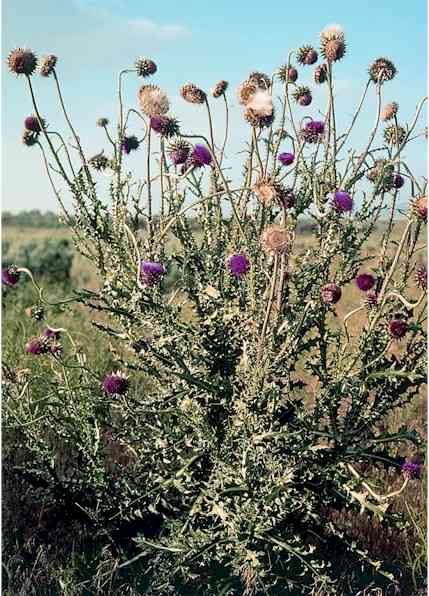|
Description:
Musk thistle, a biennial or occasionally a
winter annual plant, can reach a height of 6
feet or more and reproduces by seed. Plants have
a large, fleshy taproot. Young plants develop
into large rosettes of dark green, deeply lobed,
spiny leaves that can be over 14 inches long.
Leaves have a light yellow vein. Flowering
plants produce single or multiple winged stems,
each with smaller leaves and a single, terminal
flowerhead. Each flowerhead is 2 to 3 inches in
diameter and droops at first (giving the plant
another common name of nodding thistle). The
bracts surrounding each flowerhead are armed
with stiff spines. The flowers are pink to
rose-purple, maturing into straw-colored seeds
with a white plume of soft bristles.
|
 |
|
Management Guidelines:
Type and Class of
Livestock: All
classes of sheep, goats, and cattle.
Grazing Objective:
Prevent seed production, reduce plant size and
vigor.
Growth Stage for
Treatment:
Graze musk thistle heavily during the rosette to
bolting stage. Repeated grazing at approximately
two-week intervals will be necessary to prevent
flowering and seed production. May need to graze
only once in a season if grazing occurs in the
early flowering stage and site conditions limit
regrowth. At least three successive years of
grazing are needed to reduce populations.
Potential Effectiveness:
Grazing musk thistle reduces plant size,
density, and reproductive efficiency. Sheep and
goats will readily graze musk thistle; cattle
will not graze musk thistle beyond the early bud
stage. Grazing works best when combined with a
fall herbicide treatment to control new
seedlings and escaped plants. |
|
References:
Hull, A.C Jr., and J.O. Evans. 1973. Musk
thistle (Carduus nutans): An undesirable
range plant. Journal of Range Management
26:383-385.
Huwer, R.K., M.J.
Neave, P.M. Dowling, W.M. Lonsdale, A.W.
Sheppard, D.T. Briese, and D.L. Michalk. 2002.
Integrated weed management (IWM) in perennial
pasture using pasture and grazing management,
herbicide strategies and biological control.
In: J.H. Spafford, J. Dodd, and J.H. Moore
[EDS.]. Perth, Australia: Proceedings of the
13th Australian Weeds Conference. Plant
Protection Society of WA. P. 727–730.
Kadrmas, T., and W.S. Johnson. 2002. Managing
Musk thistle. University of Nevada Reno
Cooperative Extension Fact Sheet FS-02-55.
Available at: http://www.ag.unr.edu/wsj/Wayne/Managing
Musk Thistle FS 02-55.pdf. Accessed 03
September 2006.
Kristi, R.K. 2001. Competitive effects of
cool-season grasses on re-establishment of three
weed species. Weed Technology 15:885-891.
Lamming, L. 2001. Successfully controlling
noxious weeds with goats. Pesticides and You
21:19-23. |